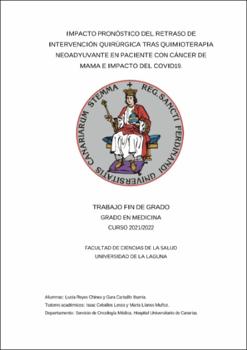Impacto pronóstico del retraso de intervención quirúrgica tras quimioterapia neoadyuvante en paciente con cáncer de mama e impacto del COVID19.
Fecha
2022Resumen
Introducción: el cáncer de mama es el cáncer más frecuente en las mujeres. En los últimos
años, se recalca la importancia que existe en el tiempo en el que las pacientes tratadas con
quimioterapia neoadyuvante tienen que esperar hasta que se lleva a cabo el tratamiento
quirúrgico. Es por ello, que el objetivo que tiene este Trabajo de Fin de Grado es observar si
en el Hospital Universitario de Canarias (HUC) la demora entre la quimioterapia neoadyuvante
y la cirugía supone un peor pronóstico para las pacientes. Además, se compara el tiempo medio
de espera entre la época pre-COVID19 y COVID19.
Material y métodos: se recogieron un total de 180 pacientes del Registro de tumores del HUC
del año 2012-2016 y del año 2020 que cumplían con los criterios de inclusión y de exclusión.
Se dividieron en cuatro grupos según el tiempo entre la fecha de finalización de quimioterapia
y la fecha final de cirugía, analizándose la supervivencia libre de enfermedad en las que
esperaron más días.
Resultados: de 121 pacientes recogidas entre los años 2012-2016, 21 (17,35%) esperaron 28
días o menos, 40 (33,06%) esperaron entre 29-34 días, 31 (25,62%) esperaron entre 35-41 días
y 29 (23,97%) esperaron 42 o más días. Por otro lado, el tiempo medio de espera pre-COVID19
fue de 35 días frente a 27 días en el periodo de la pandemia.
Conclusiones: a pesar de no encontrar diferencias significativas en el pronóstico de las
pacientes que superaron los 42 días en comparación con las otras pacientes, sí pudimos
observar que el tiempo de espera para la quimioterapia en época pre-COVID19 era 24 días,
menor que en la época COVID19, de 32 días de media. Mientras que el tiempo de espera a la
cirugía era mayor antes de la pandemia que durante la misma. Introduction: breast cancer is the most common cancer in women. In recent years, the
importance of the time in which patients treated with neoadjuvant chemotherapy must wait
until the surgical treatment has been emphasized. That is why the objective of this Final Degree
Project is to observe if this period is met at the University Hospital of the Canary Islands (HUC)
and if this is not the case, to observe if a time greater than 28 days between neoadjuvant
chemotherapy and surgery have a worse prognosis for patients.
Material and methods: A total of 180 patients were collected from the HUC Tumor Registry
from 2012-2016 and 2020 who achieved the inclusion and exclusion criteria. They were
divided into three groups according to the time between the end date of chemotherapy and the
end date of surgery, analyzing disease-free survival.
Results: among the 121 patients collected between the years 2012-2016, 21 (17.35%) waited
28 days or less, 40 (33.06%) waited between 29-34 days, 31 (25.62%) waited between 35-41
days and 29 (23.97%) waited 42 or more days. On the other hand, the average waiting time
pre-COVID19 was 35 days compared to 27 days in the post-pandemic period.
Conclusion: despite not finding significant differences in the prognosis of patients who
exceeded 42 days compared to the other patients, we were able to observe that the waiting time
for chemotherapy in the pre-COVID19 era was 24 days, less than in the COVID19 era with 32
days on average. While the waiting time for surgery was longer before the pandemic than
during it.





